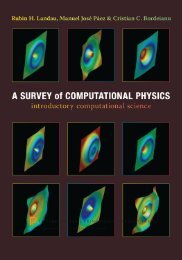Statistical Physics
Statistical Physics
Statistical Physics
- No tags were found...
Create successful ePaper yourself
Turn your PDF publications into a flip-book with our unique Google optimized e-Paper software.
1Thermal Equilibrium and the Principleof Equal ProbabilityIn this chapter, a brief introduction to thermal and statistical physics is given.We describe in general terms the systems to which this branch of physicscan be applied, the relationship of thermal and statistical physics to otherbranches of physics, and the objectives of thermal and statistical physics. Weconsider the kinetic theory of gas molecules, and thereby introduce the essenceof statistical physics.1.1 Introduction to Thermal and <strong>Statistical</strong> <strong>Physics</strong>It is well known that matter is constructed from atoms. The inner structureof atoms, of nuclei, and of nucleons has been clarified; the forces that act onthese particles and the laws of motion for them are known. However, we cannotunderstand the properties of the pieces of matter of moderate size around us onthe basis of these laws only. Ordinary matter consists of macroscopic numbersof atoms, ions, and electrons. For such macroscopic matter, knowing the rulesof motion for individual particles is not enough to understand its properties.We need additional laws to understand the properties of gases, liquids, solids,and solid solutions of macroscopic size. Such additional laws are provided bythermal physics and statistical physics.Thermal physics, or thermodynamics, treats a macroscopic sample of mattersuch as a gas or a solid as a black box. It provides general laws for theresponse of matter to actions from the environment. For instance, when weexert a force on a volume of gas in the form of a pressure, the gas will contract.When we give energy in the form of heat to a gas, it will either expand orincrease its pressure. There are general relationships between these responses.Thermodynamics gives us such relationships. This branch of physics evolvedfrom the necessity to increase the efficiency of the conversion of heat to work,which became important after the Industrial Revolution. The laws of thermodynamicsare quite general; they are independent of the species of the atomsfrom which the matter is constructed, and independent of the interactions











![Práctica [PDF] - Universidad de Carabobo, FACYT - computacion](https://img.yumpu.com/48491415/1/190x245/practica-pdf-universidad-de-carabobo-facyt-computacion.jpg?quality=85)




